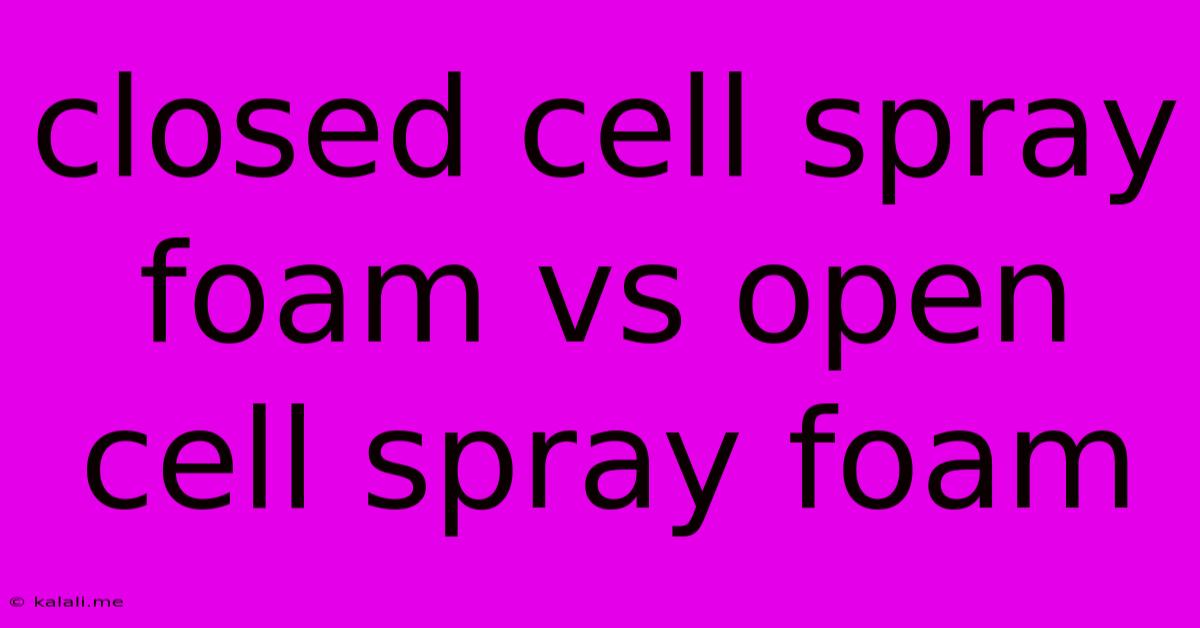Closed Cell Spray Foam Vs Open Cell Spray Foam
Kalali
Jun 03, 2025 · 4 min read

Table of Contents
Closed Cell Spray Foam vs. Open Cell Spray Foam: Which Insulation is Right for You?
Choosing the right insulation for your home is a crucial decision impacting energy efficiency, comfort, and long-term cost savings. Spray foam insulation, in both open-cell and closed-cell varieties, has gained significant popularity due to its superior performance compared to traditional insulation methods. However, understanding the key differences between closed-cell and open-cell spray foam is vital to making an informed choice. This article delves into the pros and cons of each, helping you determine which type best suits your specific needs and budget.
What's the difference? The core difference lies in the cell structure of the foam. Closed-cell spray foam has tiny, sealed air pockets, while open-cell spray foam has larger, interconnected cells. This structural difference leads to significant variations in their properties, influencing their application and suitability for different projects.
Closed-Cell Spray Foam: High-Density Insulation
Closed-cell spray foam boasts a higher density than its open-cell counterpart. This high density translates to several key advantages:
- Superior R-Value: Closed-cell foam offers a significantly higher R-value per inch, meaning it provides better thermal resistance and reduces heat transfer. This results in improved energy efficiency and lower utility bills. The higher R-value also makes it suitable for colder climates.
- Excellent Air Barrier: The dense, sealed cells create a formidable air barrier, preventing air infiltration and reducing drafts. This enhances comfort and minimizes energy loss. It also improves indoor air quality by preventing the entry of allergens and pollutants.
- Moisture Resistance: The airtight nature of closed-cell foam makes it highly resistant to moisture penetration, protecting your home from mold and mildew growth. This is particularly beneficial in areas prone to humidity.
- Structural Support: The high density provides added structural support, strengthening walls and roofs, and potentially reducing sound transmission. This can be particularly advantageous in areas prone to high winds or seismic activity.
- Longer Lifespan: Because of its superior protection against moisture and air infiltration, closed-cell spray foam generally has a longer lifespan than open-cell foam.
However, closed-cell spray foam also has some drawbacks:
- Higher Cost: Closed-cell spray foam is typically more expensive than open-cell foam due to its higher density and material composition.
- Less Breathable: The airtight nature can potentially reduce breathability, requiring careful consideration of ventilation strategies to maintain a healthy indoor environment.
- More Difficult Application: Application can be more challenging, often requiring specialized equipment and experienced installers.
Open-Cell Spray Foam: A Breathable and Affordable Choice
Open-cell spray foam offers a less dense but still effective insulation solution:
- Lower Cost: Open-cell foam is generally more affordable than closed-cell foam, making it a budget-friendly option.
- Breathability: The interconnected cells allow for some vapor permeability, which can help regulate humidity levels within the home. This can be advantageous in climates with moderate humidity.
- Better Sound Absorption: Open-cell foam is often considered better at absorbing sound compared to closed-cell foam, making it a suitable option for noise reduction.
- Easier Application: The lower density makes open-cell foam slightly easier to apply in some situations.
But open-cell spray foam also has some limitations:
- Lower R-Value: It offers a lower R-value per inch compared to closed-cell foam, requiring a thicker application to achieve comparable thermal performance.
- Less Moisture Resistance: It is more susceptible to moisture absorption, increasing the risk of mold and mildew growth if not properly installed and protected.
- Less Structural Support: It provides less structural support compared to closed-cell foam.
Choosing the Right Spray Foam for Your Home
The best choice between closed-cell and open-cell spray foam depends on your specific needs and priorities. Consider the following factors:
- Climate: Closed-cell is ideal for colder climates due to its higher R-value. Open-cell can suffice in milder climates.
- Budget: Open-cell offers a more budget-friendly option.
- Moisture Concerns: Closed-cell offers superior moisture resistance.
- Sound Dampening Needs: Open-cell generally provides better sound absorption.
- Structural Needs: Closed-cell provides superior structural support.
Ultimately, consulting with a qualified insulation professional is recommended to assess your home's specific requirements and determine the most appropriate type of spray foam insulation. They can help you navigate the complexities of insulation choices, ensuring you make the best decision for your home's long-term energy efficiency, comfort, and value.
Latest Posts
Latest Posts
-
Do Servers Still Run With Chunk Loader Minecraft
Jun 04, 2025
-
Is The Niv Bible A Catholic Bible
Jun 04, 2025
-
Ask A Yes Or No Question
Jun 04, 2025
-
Please Allow Me To Explain Me Better
Jun 04, 2025
-
How See If You Have Nudes Online
Jun 04, 2025
Related Post
Thank you for visiting our website which covers about Closed Cell Spray Foam Vs Open Cell Spray Foam . We hope the information provided has been useful to you. Feel free to contact us if you have any questions or need further assistance. See you next time and don't miss to bookmark.